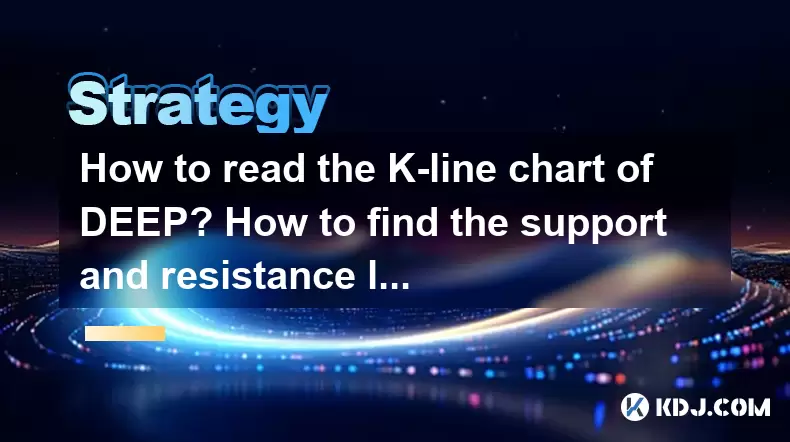-
 bitcoin
bitcoin $124586.364639 USD
0.62% -
 ethereum
ethereum $4670.671710 USD
3.33% -
 xrp
xrp $2.983701 USD
0.18% -
 tether
tether $1.000175 USD
-0.03% -
 bnb
bnb $1209.430642 USD
2.76% -
 solana
solana $231.365861 USD
0.51% -
 usd-coin
usd-coin $0.999665 USD
-0.02% -
 dogecoin
dogecoin $0.264657 USD
4.46% -
 tron
tron $0.346415 USD
1.60% -
 cardano
cardano $0.871586 USD
3.70% -
 chainlink
chainlink $23.451270 USD
7.56% -
 hyperliquid
hyperliquid $46.860071 USD
-2.96% -
 ethena-usde
ethena-usde $1.000120 USD
0.04% -
 sui
sui $3.611279 USD
1.08% -
 stellar
stellar $0.407149 USD
0.96%
How to read the K-line chart of DEEP? How to find the support and resistance levels?
To analyze DEEP's price movements, use K-line charts to identify support and resistance levels, and confirm with technical indicators like RSI and Bollinger Bands.
May 21, 2025 at 04:36 am

Understanding the K-line chart, also known as the candlestick chart, is crucial for analyzing the price movements of cryptocurrencies like DEEP. The K-line chart provides a visual representation of the price action over a specific period, helping traders make informed decisions. In this article, we will delve into how to read the K-line chart of DEEP and how to identify the support and resistance levels, which are essential for trading strategies.
Understanding the Basics of K-line Charts
K-line charts are a popular tool used by traders to analyze price movements. Each 'candlestick' on the chart represents the price action of DEEP over a set time frame, such as one minute, one hour, or one day. The candlestick is composed of a body and wicks (or shadows). The body of the candlestick shows the opening and closing prices, while the wicks indicate the highest and lowest prices during the period.
- Bullish Candlestick: If the closing price is higher than the opening price, the body of the candlestick is usually colored in green or white. This indicates that the price of DEEP has risen during that period.
- Bearish Candlestick: If the closing price is lower than the opening price, the body of the candlestick is typically colored in red or black. This shows that the price of DEEP has fallen during that period.
Identifying Key Patterns in K-line Charts
Recognizing patterns in K-line charts can provide insights into potential future price movements of DEEP. Here are some common patterns to look out for:
- Doji: A Doji candlestick occurs when the opening and closing prices are very close or identical, resulting in a small or nonexistent body. This pattern suggests indecision in the market and can signal a potential reversal.
- Hammer and Hanging Man: These patterns have small bodies and long lower wicks. A Hammer appears during a downtrend and can signal a bullish reversal, while a Hanging Man appears during an uptrend and can indicate a bearish reversal.
- Engulfing Patterns: An engulfing pattern occurs when a larger candlestick completely engulfs the body of the previous smaller candlestick. A Bullish Engulfing pattern suggests a potential upward reversal, whereas a Bearish Engulfing pattern indicates a possible downward reversal.
Analyzing Volume in K-line Charts
Volume is another critical factor to consider when reading the K-line chart of DEEP. Volume represents the number of DEEP tokens traded during a specific period and can confirm the strength of a price move.
- High Volume: If a price movement is accompanied by high volume, it indicates strong interest and confirms the validity of the move. For instance, if DEEP's price rises with high volume, it suggests strong buying pressure.
- Low Volume: Conversely, if a price movement occurs with low volume, it may indicate weak interest and could signal a potential reversal. For example, if DEEP's price falls with low volume, it might suggest a lack of selling pressure.
Finding Support and Resistance Levels
Support and resistance levels are crucial for traders as they help identify potential entry and exit points for DEEP. These levels are areas where the price of DEEP tends to reverse or stall.
- Support Level: A support level is a price point where the price of DEEP tends to find support as it falls. This means that the price is more likely to bounce back up from this level. To identify a support level, look for areas where the price has previously reversed upwards multiple times.
- Resistance Level: A resistance level is a price point where the price of DEEP tends to meet resistance as it rises. This means that the price is more likely to fall back down from this level. To identify a resistance level, look for areas where the price has previously reversed downwards multiple times.
Using Technical Indicators to Confirm Levels
Technical indicators can help confirm the support and resistance levels identified on the K-line chart of DEEP. Here are some commonly used indicators:
- Moving Averages: Moving averages smooth out price data to identify trends over time. The Simple Moving Average (SMA) and Exponential Moving Average (EMA) can help identify potential support and resistance levels. For instance, if the price of DEEP approaches the SMA or EMA, it may act as a support or resistance level.
- Relative Strength Index (RSI): The RSI is a momentum oscillator that measures the speed and change of price movements. If the RSI reaches overbought levels (typically above 70), it may indicate a potential resistance level. Conversely, if the RSI reaches oversold levels (typically below 30), it may suggest a potential support level.
- Bollinger Bands: Bollinger Bands consist of a middle band (usually a 20-day SMA) and two outer bands that are standard deviations away from the middle band. The upper band can act as a resistance level, while the lower band can serve as a support level.
Applying Support and Resistance Levels in Trading
Once you have identified the support and resistance levels on the K-line chart of DEEP, you can use them to develop trading strategies. Here are some ways to apply these levels:
- Buying at Support: Traders often look to buy DEEP when the price approaches a strong support level, anticipating a bounce back up. For example, if DEEP's price reaches a support level at $0.50 and shows signs of reversing upwards, it might be a good entry point.
- Selling at Resistance: Conversely, traders may look to sell or short DEEP when the price approaches a strong resistance level, expecting a fall back down. For instance, if DEEP's price reaches a resistance level at $0.70 and shows signs of reversing downwards, it could be a good exit point.
- Breakouts: A breakout occurs when the price of DEEP moves beyond a support or resistance level. If the price breaks above a resistance level with high volume, it could signal a bullish trend. Conversely, if the price breaks below a support level with high volume, it might indicate a bearish trend.
Frequently Asked Questions
Q: How often should I check the K-line chart of DEEP for trading?A: The frequency of checking the K-line chart depends on your trading style. For day traders, checking the chart every few minutes to an hour might be necessary. For swing traders, checking the chart daily or weekly could be sufficient. It's essential to align your chart-checking frequency with your trading strategy and time horizon.
Q: Can the support and resistance levels of DEEP change over time?A: Yes, support and resistance levels can change as market conditions evolve. They are not fixed and can shift based on new price data and market sentiment. It's important to regularly reassess these levels and adjust your trading strategy accordingly.
Q: Are there any tools or platforms that can help me analyze the K-line chart of DEEP more effectively?A: Yes, several trading platforms and tools can enhance your analysis of DEEP's K-line chart. Platforms like TradingView, Binance, and Coinbase offer advanced charting tools and technical indicators. Additionally, tools like CryptoWatch and Coinigy provide real-time data and customizable charts to help you make more informed trading decisions.
Q: How can I combine K-line chart analysis with other forms of analysis for trading DEEP?A: Combining K-line chart analysis with other forms of analysis can provide a more comprehensive view of DEEP's market trends. For instance, you can use fundamental analysis to assess the project's underlying value and potential. Additionally, sentiment analysis, which involves monitoring social media and news, can help gauge market sentiment. By integrating these different forms of analysis, you can make more well-rounded trading decisions.
Disclaimer:info@kdj.com
The information provided is not trading advice. kdj.com does not assume any responsibility for any investments made based on the information provided in this article. Cryptocurrencies are highly volatile and it is highly recommended that you invest with caution after thorough research!
If you believe that the content used on this website infringes your copyright, please contact us immediately (info@kdj.com) and we will delete it promptly.
- BlockDAG, DOGE, HYPE Sponsorship: Crypto Trends Shaping 2025
- 2025-10-01 00:25:13
- Deutsche Börse and Circle: A StableCoin Adoption Powerhouse in Europe
- 2025-10-01 00:25:13
- BlockDAG's Presale Buzz: Is It the Crypto to Watch in October 2025?
- 2025-10-01 00:30:13
- Bitcoin, Crypto, and IQ: When Genius Meets Digital Gold?
- 2025-10-01 00:30:13
- Stablecoins, American Innovation, and Wallet Tokens: The Next Frontier
- 2025-10-01 00:35:12
- NBU, Coins, and Crypto in Ukraine: A New Yorker's Take
- 2025-10-01 00:45:14
Related knowledge

Practical parameter settings for a Bitcoin multi-timeframe moving average system
Sep 18,2025 at 10:54pm
Optimizing Timeframe Combinations for Bitcoin Trading1. Selecting appropriate timeframes is crucial when building a multi-timeframe moving average sys...

How can I filter out false breakouts in Dogecoin high-frequency trading?
Sep 22,2025 at 01:00am
Understanding False Breakouts in Dogecoin Trading1. A false breakout occurs when Dogecoin's price appears to move beyond a defined support or resistan...

Techniques for identifying tops and bottoms in the Bitcoin on-chain NVT model
Sep 20,2025 at 07:54pm
Understanding the NVT Model in Bitcoin Analysis1. The Network Value to Transactions (NVT) ratio is often described as the 'P/E ratio' of the cryptocur...

What does the surge in open interest in Bitcoincoin futures mean?
Sep 20,2025 at 11:18pm
Understanding the Surge in Dogecoin Futures Open Interest1. A surge in open interest within Dogecoin futures indicates a growing number of active cont...

How can I use the Ethereum USDT premium to gauge market sentiment?
Sep 18,2025 at 11:55pm
Understanding the Ethereum USDT Premium1. The Ethereum USDT premium refers to the price difference between USDT (Tether) traded on Ethereum-based plat...

What should I do if Ethereum staking yields decline?
Sep 20,2025 at 06:18am
Understanding the Causes Behind Declining Ethereum Staking Yields1. The Ethereum network transitioned to a proof-of-stake consensus mechanism with the...

Practical parameter settings for a Bitcoin multi-timeframe moving average system
Sep 18,2025 at 10:54pm
Optimizing Timeframe Combinations for Bitcoin Trading1. Selecting appropriate timeframes is crucial when building a multi-timeframe moving average sys...

How can I filter out false breakouts in Dogecoin high-frequency trading?
Sep 22,2025 at 01:00am
Understanding False Breakouts in Dogecoin Trading1. A false breakout occurs when Dogecoin's price appears to move beyond a defined support or resistan...

Techniques for identifying tops and bottoms in the Bitcoin on-chain NVT model
Sep 20,2025 at 07:54pm
Understanding the NVT Model in Bitcoin Analysis1. The Network Value to Transactions (NVT) ratio is often described as the 'P/E ratio' of the cryptocur...

What does the surge in open interest in Bitcoincoin futures mean?
Sep 20,2025 at 11:18pm
Understanding the Surge in Dogecoin Futures Open Interest1. A surge in open interest within Dogecoin futures indicates a growing number of active cont...

How can I use the Ethereum USDT premium to gauge market sentiment?
Sep 18,2025 at 11:55pm
Understanding the Ethereum USDT Premium1. The Ethereum USDT premium refers to the price difference between USDT (Tether) traded on Ethereum-based plat...

What should I do if Ethereum staking yields decline?
Sep 20,2025 at 06:18am
Understanding the Causes Behind Declining Ethereum Staking Yields1. The Ethereum network transitioned to a proof-of-stake consensus mechanism with the...
See all articles










































































